02/02/2015 By Robbin Laird
During my trip to Australia last year, I had a chance to visit two new squadrons within the Royal Australian Air Force: the Wedgetail and KC-30A squadrons.
Both are part of the transformation of the RAAF into a powerful, integrated medium weight air force capable of significant global reach.
In a recent interview with the head of the Air Mobility Group, Air Commodore McDonald, that process of change associated with the transition for Air Lift to Air Mobility was described as part of understanding where the AMG is now and where it is headed moving forward.
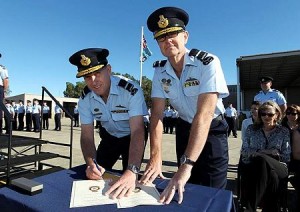
And Air Vice-Marshal (Ret.) John Blackburn described in an interview last Fall the overall impact of the transformation of the RAAF:
Prior to the current modernization program, the RAAF would need several months warning time before they could assemble a strike force. And they did not have the logistic capability to support that force at long distance from Australia.
For example, the RAAF had C-130s and a small amount of B 707 tanking support which was in reality only a training capability.
Contrast that to today where in the current Middle East deployment, in a matter of weeks, the forces were able to respond rapidly and to deploy against the threat.
And they have an ability to provide the complete logistical support as well to the force. The C-17 and the KC-30As have been crucial to this effort, and is why the government is seeking to acquire additional C-17s and KC-30As as well.
It is a mindset as well as capability change as well. In today’s world you are not going to have six months warning with that amount of time to respond. You need forces that can be gathered together rapidly and deployed as a package.
Our government wants to insert forces rapidly to deal with crises; not to have to wait for a long period to deploy. We don’t want to respond to the PM’s request to deploy with: “Call us in six months, and we will let you know when we are on our way. Governments want real options; not a recorded message .”
In this interview with Air Commodore Gary Martin, currently the Air Attache in the United States, but previously the Air Lift Commander just prior to McDonald taking Command the process of transition is the focus of attention.
Martin was extensively involved in the process of introducing the C-17s into the RAAF and was the Commander in charge of the Air Lift Command as the KC-30A came into the fleet.
He looks at the very significant cultural shift represented by the introduction and operation of the C-17 fleet and the challenges of bringing the KC-30A to operational reality and the powerful synergy which operating both platforms brings to the Australian forces.
Especially noteworthy is the emphasis which Martin placed on the process of cultural change, not just for the RAAF, but for the government, the Australian Army and the emergency aid agencies in Australia.
Question: You took command of the Air Lift Group in late 2011. The ALG prior to the C-17 was basically defined by the operational span of the C-130 and the Caribou. And you were involved with the C-17 transition.
How would you describe the shift?
Air Commodore Martin: I took over in late 2010 and was confronted with a set of demanding humanitarian support situations ranging from support to Tsunami relief in Japan to the earthquake in New Zealand and a fairly serious moment at Christmas Island.
We were in the process of shifting from a C-130 centric mind set to a C-17 mind set by which I mean shifting from thinking in terms of days to support an operation to hours.
The initial cultural change was on the part of the Australian Government.
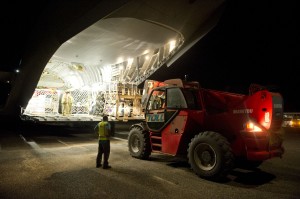
Government suddenly realized that they had the speed and capacity to make an Australian flag appear anywhere in the South Pacific region within 12 hours. And then have a revisit capability within the next 24 hours or less if you’re utilizing two or more aircraft. This was a shift from a three to four day process to one of 12 hours.
The Prime Minister realized that the Government could have an immediate effect, and they could make a decision the night before, by 3:00 pm the following day an aircraft will be on the ground, with a load of whatever was required. And then can present to the Australian public the initial results on the 6 PM news.
This was a fundamental change to National power for Australia.
This changed us at ALG from being a tactical airlift Group to strategic airlift Group. With the C130, it always took a day to get offshore and then another day to get to the first point after that.
With the C-17, we could now conducted an operation from anywhere in Australia, pick up a load in Australia, get offshore, and come back home the next day.
This was a quantum leap for the RAAF and for the Government.
Next up was the cultural impact on the Army.
Rather than thinking of a relatively slow rollout of a support mission in terms of days, they now had to prepare for a response in hours. The Army had to realize their mobility now didn’t have that luxury of having 24 hours or 48 hours notice to move.
Because the aircraft that was going to carry them was going to be there within four to five hours, and then offshore and delivered within the next eight hours so they needed to be capable of such rapid insertion.
The Army then had to go through a complete redistribution process with its battalions and infantries for those who were on the ready lift notice because we were bringing down reaction times into the 12-hour picture, which is a working day. Food stores, ammunition, and water bottles, simple things like that now had to be on higher levels of readiness.
Emergency services for state governments of Victoria and Queensland had to adjust as well.
These two agencies were highly utilized for the rescue teams that were deployed to assist with the earthquake in Christchurch, and the tsunami in Japan. With the development of the reaction times that the RAAF now had with its C-17 fleet, in less than a day from the period of notification they had to call their people in, or volunteers, put them into their readiness vehicles, drive out to the base, load the equipment, and be deployed within a day, such as we did in Tsunami support to Japan.
The Army and the Emergency Services needed to adjust to the speed and load capacity of the C-17 and to shift from the C-130 centric mindset.
Everyone now realized that they had four times the C-130 capacity and that they could make a huge affect when they first touched down on the ground, rather than going through a series of flights to get that effect.
This led to the two State emergency services investing 3-4 million dollars in improving their ability to leverage a C-17 insertion capability to enable their ability to operate anywhere in the world.
It was certainly a game changer in the top most strategic thought processes of the National Security Council.
They could make a decision at a nighttime meeting and the C-17 force could be executing the mission the next day.
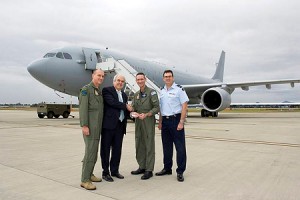
Question: Both the C-17 and KC-30A are multi-mission aircraft and how do you train to operate a diversity of missions?
Air Commodore Martin: Multi-mission is challenging.
For example, right after we flew missions to support Japan in the tsunami crisis we came back to Australia to conduct fire support activity and then earthquake support.
We received our training with the USAF and because the USAF had honed mult-mission skills with regard to their C-17s this was a relatively easy transition.
Yet the human stress factor was significant.
Rather than the tactical operational envelope, we were now flying great distances with the C-17. We worked closely with our RAAF aviation medicine experts to understand how we could best operate 15 hour missions covering 5-10 time zones.
We were tripling the extent of what our air mobility crews could do as compare to operating the C-130.
This led us to redesigning the entire focus of how to use the aircraft and the crews to execute a variety of missions over great distance and with significant speed.
Question: As you built up deployment experience with the C-17, obviously a major challenge or opportunity was to sort out how to coordinate your air lift operations with the USAF and others in the region to maximize the effect on the ground.
How did you approach this challenge or opportunity?
Air Commodore Martin: We needed to think through two problems.
First, we needed to work through cargo management from the Chinook through the C-17 for the RAAF.
Second, we need to work through how to marry up our cargos with USAF or other regional Air Forces to maximize effectiveness.
We have experienced a very successfully integrated with Scott Air Force base and TRANSCOM.
We are utilizing links between computer stations on different networks to be able to see each other’s tasking processes and be able to offer the ability to do airlift on behalf of the two Air Forces.
Now we can actually use a force, not just the Australian Force or the United States Air Force, but a force of air mobility assets, the right size, the right shape to actually affect the load that’s on the ground.
For years we’ve been flying over the same territories and bypassing each other’s airports and loads that are waiting for distribution because we were on our tasks. It was all viewed as being on sovereign tasks.
The get to this point meant that we had to think through how to shape a common approach.
We had to have a payment process again which is worked on common hours valuation process. And this accounting system had to work on an annual basis so the averaging process occurs – so you’re not having to get tied up into who’s charging for what on a monthly basis as per a commercial Fed Ex type of contract.
Question: Clearly, another aspect is the question of the shared sustainment approach of the C-17 as well.
When I was a PACAF last year, I was informed that the RAAF and the USAF have a common approach to managing spares and doing repairs.
How does this work?
Parts Sharing Among Allies: The Case of the C-17 from SldInfo.com on Vimeo.
Air Commodore Martin: You are talking about what has become the Boeing managed Global Sustainment Program.
It is a C-17 support mechanism that was designed for the United States Air Force, so it can maneuver anywhere around the world. And so, people who have received common training in different units could look after that aircraft as it deployed globally.
As international sales started with Britain and then with Australia with the C-17 in completely different hemispheres of the world, we felt that this agreement still was USAF centric. So if a British C-17 was visiting Australia and had an engine malfunction or something go wrong with it, and needed technical support with more than a couple of technicians it was carrying, Australia could not do anything to it without Britain asking America’s permission to do that work.
That worked for about the first six weeks.
Then we realized that this was obviously a shortfall in our ability to conduct worldwide operations and support.
We now have a totally different approach.
In the GSP we do not own the common spares; our common spares are part of a global C-17 inventory. Any of our air crew or technicians can walk up to any C-17 support area in the world, and actually submit an order form through which looks like a United States document.
And because the partner technicians have gone through the same training processes, they can help fix that malfunction that’s occurred.
This is the gold standard for working a multinational fleet and we see a similar process being established for the F-35 and we would certainly like to see that for the KC-30A as well.
With aircraft that operate globally, you do not want to be limited by the logistics simply being supported by national parts, which may well not be located at the point of attack or in the area of interest. This makes no sense with the multi-national and multi-mission aircraft becoming the norm for 21st century air forces.
Question: Let us now discuss the coming of the KC-30A to the RAAF and the process of transition.
You were at the heart of this effort, and could you take us back in time to provide some history on the initial efforts?
Air Commodore Martin: During my time at the Air Lift Group we took ownership of the KC-30A and worked with Airbus Military and Qantas Defence to craft an operational capability for the fleet.
The Chief of Air Force of the RAAF was impatient to add the tanking capability to the fleet as we had ceased our original B-707 tanking back in 2008. We were thin on personnel with tanking experience and knew that we would need to ramp up this capability as soon as possible.
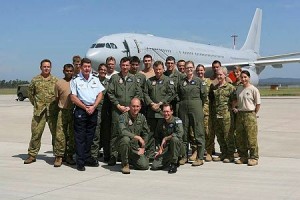
And the new tanker was much larger than our legacy aircraft, so we realised that there would be challenges associated with our first of series aircraft fleet.
We were a demanding customer because of the pressures to get the KC-30A into operation.
Overall, our Chief was looking for the ability of the RAAF to deploy a sustainable insertion package with the C-17s and KC-30As moving out together to bring significant capability to an area of interest.
Because the KC-30A holds the fuel for its AAR in its wings, we can carry personnel and their baggage onboard the aircraft. This means that the C-17 can carry the heavy equipment; the KC-30A the fuel for AAR and the personnel to operate the capabilities when landing in an area of operation.
This combined capability is an essential force package for operating at a distance for the Australian forces.
But to get to that point has taken time.
The aircraft is a software-enabled aircraft and we had challenges to deal with to get the entire package to work operationally.
So all of our processes in the first year were aimed at getting the aircraft safely airborne, conducting our operational training and evaluation of the squadron members. We weren’t using the boom at this stage, just the pods and bringing them into operational service.
And as you know, we started with the process of getting the hose and drogue system to work with our Hornets, and then have moved onto the boom.
We clearly see both for our own use and working with coalition partners. Having a tanker that can do both and can refuel from such a large tanker reserve of fuel is a huge operational advantage for us.
Another priority was to get the whole logistical system to kick in.
Initially, we had just taken delivery of a limited spares package and were the first nation to use the aircraft. So there was no experience with mean failure rates of parts and other data important to establishing a functioning logistics system.
But the working relationship we had with Qantas Defence and Airbus Military allowed us to work through the challenges to get where we are today.
After we established a good workflow to deal with any problems evident as we starting using the aircraft, the 24-hour work flow between Spain and Australia worked to our advantage.
We had Airbus Military, and RAAF personnel in both Australia and Spain. We would identify problems and craft partial solutions and then send those by electronic means to Spain where the team would then work on them while we slept; We would then be able the next day to take their solution set and continue to work on it, and then we could send at the end of our work day our work on the solution set, etc.
It was a lot of coordination.
It took us two-and-a-half years to have a stabilized tanking process with the RAAF and fighter force and for them to integrate with our tanker aircraft.
Question: Now that the KC-30A is deployed to Iraq and certainly demonstrating its operational value, what is next for the aircraft?
Air Commodore Martin: We see the C-17 and KC-30A pairing as a powerful one; that is why the Government is seeking to add additional C-17 aircraft.
When we bought the KC-30A we were the first Air Force to move to operational use of the aircraft.
There are always challenges to doing that but we learned a lot and believe we have much to share with other users.
Now there is a global fleet of Airbus tankers flying.
We would like to see both the user group plus-ed up in working with Airbus to shape the evolution of the aircraft, but also see put in place a system similar to Boeing’s Global Sustainment Partnership or the F-35 global sustainment approach.
We think the KC-30A will clearly operate globally and become an even more important aircraft over time for the RAAF and allied forces, as we add capabilities to the aircraft to operate in the battlespace.
Indeed, because of the configuration of the KC-30A, we can use significant space onboard the aircraft to handle C2 and various types of digital data.
The tanker is at the far end of the battlespace and is well positioned to push and pull data. We would like to see the global users of the aircraft shape some common standards and common role equipment acquisitions as well.
That is the advantage of the multi-mission, multi-national programs which are so important to the allied air forces of the 21st century.
I think what you’re going to see now is not only air mobility aircraft provide fuel and equipment, but also be a key asset in terms of data transfer.
That’s now the power of this fleet.
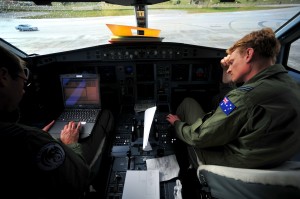
It gives you an aircraft that can sit back in a supply position to go back into the main bases with operational data being transferred to and from those aircraft in the area for free.
It doesn’t cost the aircraft one cent, it’s just the hardware and software fitted to the aircraft itself.
This capacity doesn’t have to bother the KC-30A aircrew as they conduct their respective missions, but it can be utilized for command and control system to actually network the whole process for our Navy deployed on the ocean, our Army personnel on the ground, or another Air Force asset of a coalition Air Force along with that of our own Royal Australian Air Force weapons systems.
Again because we have common aircraft loads and C2 systems as our partners in the world, we can enhance coalition building and their capabilities.
For a PDF version of this article to download see the following:
The RAAF and Culture Change Article
For the interview with Air Commodore Warren McDonald, the successor to Air Commodore Martin (note Marin was Air Lift Commander, but McDonald has become the Air Mobility Commander, a change which reflects the transformation as well) see the following:
Transforming the Royal Australian Air Force’s Sustainable Reach
Editor’s Note: The video above shows the KC-30A operating in the Iraq operation.
12/09/2014: Australia’s Air Task Group (ATG) consisting of six RAAF F/A-18F Super Hornets, an E-7A Wedgetail Airborne Early Warning and Control aircraft and a KC-30A Multi-Role Tanker Transport aircraft continue to support Operation OKRA with missions in Iraq.
The ATG comprises around 400 RAAF personnel who have deployed to the Middle East.
Australia’s efforts are in response to a request for assistance by the Iraqi Government in combating ISIL terrorists. Operation OKRA is the Australian Defence Force’s contribution to the international effort to combat the ISIL terrorist threat in Iraq. Australia’s contribution is being closely coordinated with the Iraqi government, Gulf nations and a broad coalition of international partners.
Credit: Australian Ministry of Defence : 11/14/14

